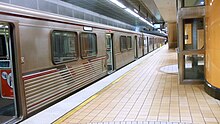B Line (Los Angeles Metro)
The current B Line is the product of a long-term plan to connect Downtown Los Angeles to central and western portions of the city with a subway system.
Original proposals in the 1980s had it running down Wilshire Boulevard to Fairfax Avenue and then north to the San Fernando Valley.
A 1985 methane explosion at a Ross Dress for Less clothing store near Fairfax gave Rep. Henry Waxman, who represented the Fairfax District, a reason to derail the project that was opposed by his constituents by prohibiting tunnelling in an alleged "methane zone" west of Western on Wilshire.
[8][9] Today's B Line was built in four minimum operating segments: Overall, the construction of the subway over the four phases cost $4.5 billion.
[13] On June 22, 1995, during the construction of MOS-2B, a sinkhole appeared on Hollywood Boulevard, barely missing several workers and causing damage to buildings on the street.
The contractor on that segment project was replaced, and because of the perceived mismanagement of Red Line construction, in 1998 voters banned the use of existing sales taxes for subway tunnelling.
Cars reach this yard by continuing past Union Station, making a right turn and surfacing at the Eastern terminus of Ducommun Street.
[19] In 2010, at the request of L.A. City Councilman Tom LaBonge, Metro staff studied the possibility of adding a station along the west bank of the Los Angeles River to 6th Street and Santa Fe Avenue.
The study suggested an alternative station at the Division 20 Yard north of 4th Street and Santa Fe Avenue.
Metro is also considering other types of mass transit for the line, including light rail and busway options.



